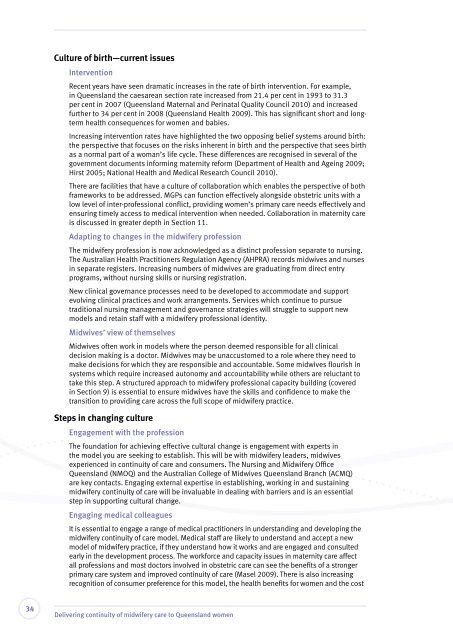Delivering continuity of midwifery care to Queensland women
Delivering continuity of midwifery care to Queensland women
Delivering continuity of midwifery care to Queensland women
Create successful ePaper yourself
Turn your PDF publications into a flip-book with our unique Google optimized e-Paper software.
Culture <strong>of</strong> birth—current issues<br />
Intervention<br />
Recent years have seen dramatic increases in the rate <strong>of</strong> birth intervention. For example,<br />
in <strong>Queensland</strong> the caesarean section rate increased from 21.4 per cent in 1993 <strong>to</strong> 31.3<br />
per cent in 2007 (<strong>Queensland</strong> Maternal and Perinatal Quality Council 2010) and increased<br />
further <strong>to</strong> 34 per cent in 2008 (<strong>Queensland</strong> Health 2009). This has significant short and longterm<br />
health consequences for <strong>women</strong> and babies.<br />
Increasing intervention rates have highlighted the two opposing belief systems around birth:<br />
the perspective that focuses on the risks inherent in birth and the perspective that sees birth<br />
as a normal part <strong>of</strong> a woman’s life cycle. These differences are recognised in several <strong>of</strong> the<br />
government documents informing maternity reform (Department <strong>of</strong> Health and Ageing 2009;<br />
Hirst 2005; National Health and Medical Research Council 2010).<br />
There are facilities that have a culture <strong>of</strong> collaboration which enables the perspective <strong>of</strong> both<br />
frameworks <strong>to</strong> be addressed. MGPs can function effectively alongside obstetric units with a<br />
low level <strong>of</strong> inter-pr<strong>of</strong>essional conflict, providing <strong>women</strong>’s primary <strong>care</strong> needs effectively and<br />
ensuring timely access <strong>to</strong> medical intervention when needed. Collaboration in maternity <strong>care</strong><br />
is discussed in greater depth in Section 11.<br />
Adapting <strong>to</strong> changes in the <strong>midwifery</strong> pr<strong>of</strong>ession<br />
The <strong>midwifery</strong> pr<strong>of</strong>ession is now acknowledged as a distinct pr<strong>of</strong>ession separate <strong>to</strong> nursing.<br />
The Australian Health Practitioners Regulation Agency (AHPRA) records midwives and nurses<br />
in separate registers. Increasing numbers <strong>of</strong> midwives are graduating from direct entry<br />
programs, without nursing skills or nursing registration.<br />
New clinical governance processes need <strong>to</strong> be developed <strong>to</strong> accommodate and support<br />
evolving clinical practices and work arrangements. Services which continue <strong>to</strong> pursue<br />
traditional nursing management and governance strategies will struggle <strong>to</strong> support new<br />
models and retain staff with a <strong>midwifery</strong> pr<strong>of</strong>essional identity.<br />
Midwives’ view <strong>of</strong> themselves<br />
Midwives <strong>of</strong>ten work in models where the person deemed responsible for all clinical<br />
decision making is a doc<strong>to</strong>r. Midwives may be unaccus<strong>to</strong>med <strong>to</strong> a role where they need <strong>to</strong><br />
make decisions for which they are responsible and accountable. Some midwives flourish in<br />
systems which require increased au<strong>to</strong>nomy and accountability while others are reluctant <strong>to</strong><br />
take this step. A structured approach <strong>to</strong> <strong>midwifery</strong> pr<strong>of</strong>essional capacity building (covered<br />
in Section 9) is essential <strong>to</strong> ensure midwives have the skills and confidence <strong>to</strong> make the<br />
transition <strong>to</strong> providing <strong>care</strong> across the full scope <strong>of</strong> <strong>midwifery</strong> practice.<br />
Steps in changing culture<br />
Engagement with the pr<strong>of</strong>ession<br />
The foundation for achieving effective cultural change is engagement with experts in<br />
the model you are seeking <strong>to</strong> establish. This will be with <strong>midwifery</strong> leaders, midwives<br />
experienced in <strong>continuity</strong> <strong>of</strong> <strong>care</strong> and consumers. The Nursing and Midwifery Office<br />
<strong>Queensland</strong> (NMOQ) and the Australian College <strong>of</strong> Midwives <strong>Queensland</strong> Branch (ACMQ)<br />
are key contacts. Engaging external expertise in establishing, working in and sustaining<br />
<strong>midwifery</strong> <strong>continuity</strong> <strong>of</strong> <strong>care</strong> will be invaluable in dealing with barriers and is an essential<br />
step in supporting cultural change.<br />
Engaging medical colleagues<br />
It is essential <strong>to</strong> engage a range <strong>of</strong> medical practitioners in understanding and developing the<br />
<strong>midwifery</strong> <strong>continuity</strong> <strong>of</strong> <strong>care</strong> model. Medical staff are likely <strong>to</strong> understand and accept a new<br />
model <strong>of</strong> <strong>midwifery</strong> practice, if they understand how it works and are engaged and consulted<br />
early in the development process. The workforce and capacity issues in maternity <strong>care</strong> affect<br />
all pr<strong>of</strong>essions and most doc<strong>to</strong>rs involved in obstetric <strong>care</strong> can see the benefits <strong>of</strong> a stronger<br />
primary <strong>care</strong> system and improved <strong>continuity</strong> <strong>of</strong> <strong>care</strong> (Masel 2009). There is also increasing<br />
recognition <strong>of</strong> consumer preference for this model, the health benefits for <strong>women</strong> and the cost<br />
34<br />
<strong>Delivering</strong> <strong>continuity</strong> <strong>of</strong> <strong>midwifery</strong> <strong>care</strong> <strong>to</strong> <strong>Queensland</strong> <strong>women</strong>
















